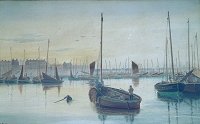Fishing for herring

Fishermen fished for herring using drift nets and the boats were named drifters after the nets. At first, the boats were small, open and sail-powered. As the fishing industry expanded more types of boats were used and they became bigger and more advanced. By the early 20th century, some fishermen used steam and motor engines.
Nets were put out at dusk when the fish were feeding and were left to drift like a giant curtain in the sea. At then end of the night the nets were hauled in and the fish shaken out. It was hard and difficult work. When the fish were onboard, the boats made for shore as fast as possible. Once in harbour the herring were unpacked using baskets and taken to the fishmarket or curing yard.
When the fishermen were back onshore, they hung the nets out to dry. They checked them for damage and mended any holes or tears. The salt water rotted the nets so the fishermen soaked them in a solution of bark to protect them. The nets were made of linen or hemp and later from cotton. Today nets are made from manmade materials which are light and strong and do not rot.
There have been many changes to fishing in the 20th century. There have been advances in boats, gear and equipment. Herring fishing has declined and overfishing has become a problem.
Herring nets
- The nets and the drift
- Hauling the nets (inc. steam capstan)
- Decline of drift netting and changes in netting
Development of herring fishing boats
- Early Scottish Fishing boats
- The Washington Report and the introduction of decking
- Expansion of the herring fishery: bigger and better boats
- Development of Engine Power
- Herring fishing boats post World War II